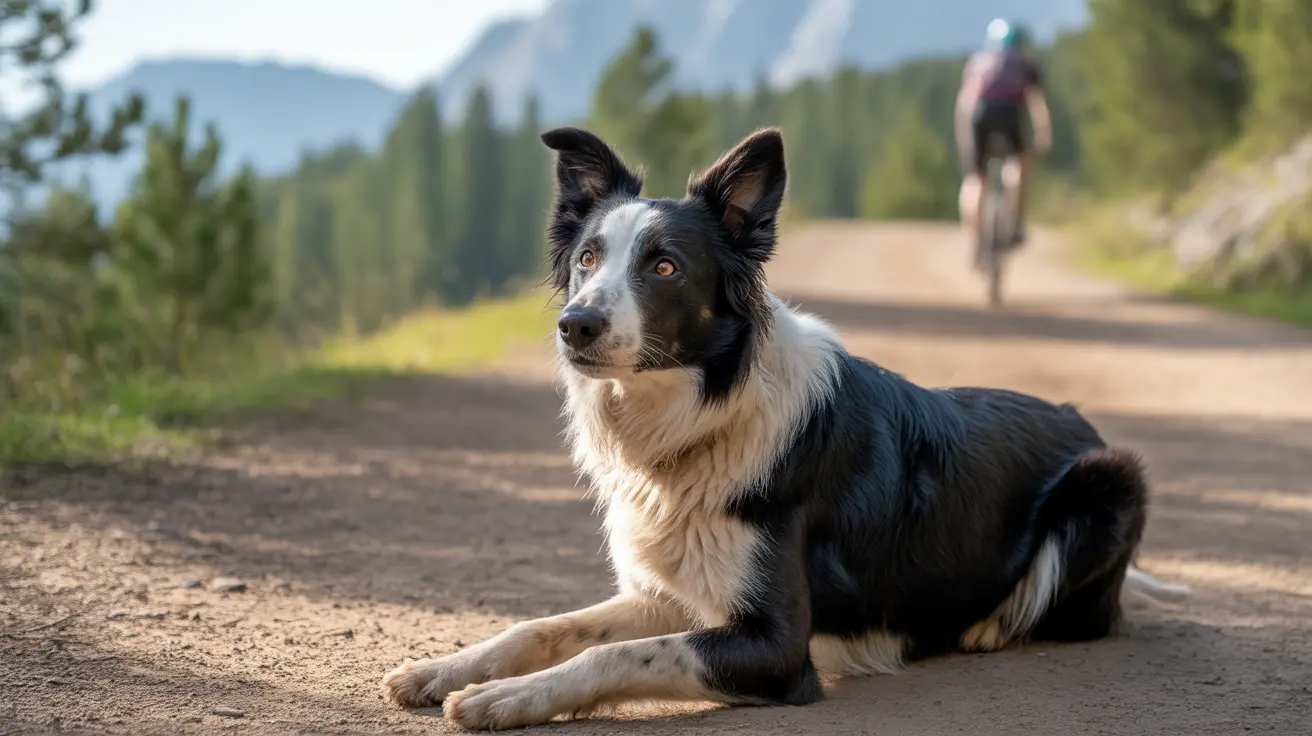How to Stop Dog Chasing Cyclists Training: A Complete Guide to Peaceful Trail Encounters
When your dog transforms from a calm companion into a frenzied cyclist-chaser the moment a bike appears, it can turn peaceful walks into stressful encounters. This behavior, common among many dogs—especially herding breeds like Border Collies and German Shepherds—isn't just embarrassing; it's dangerous for cyclists, stressful for your dog, and concerning for you as an owner.
Understanding how to stop dog chasing cyclists training requires recognizing that this behavior stems from complex emotional responses rather than simple prey drive. Dogs who chase bikes are often experiencing stress-related reactions triggered by surprise, fear, or overwhelming stimulation. The good news is that with proper training techniques, consistent management strategies, and patience, you can teach your dog to remain calm and controlled when encountering cyclists on trails.
This comprehensive guide will walk you through proven methods to transform your reactive dog into a well-behaved trail companion, ensuring safe and enjoyable outdoor experiences for everyone involved.
Understanding Why Dogs Chase Cyclists
Before diving into training solutions, it's crucial to understand that dogs don't chase cyclists out of malice or true hunting instinct. Instead, this behavior typically represents what experts call "pseudo-chasing"—a stress-related response triggered by emotional conflicts and overwhelming stimuli.
The Four Conflict Responses in Dogs
When dogs encounter stressful situations like approaching cyclists, they exhibit one of four primary conflict responses. Understanding these responses helps owners recognize their dog's emotional state and choose appropriate training strategies.
The flight response involves the dog attempting to escape or hide from the perceived threat. Dogs experiencing this response may try to run away, seek shelter behind their owner, or refuse to move forward when they spot a cyclist in the distance.
The attack response, which includes chasing behavior, occurs when dogs feel compelled to confront the moving stimulus. This isn't true aggression but rather a stress-driven attempt to control or stop the perceived threat. Dogs exhibiting this response may lunge, bark frantically, or attempt to chase cyclists.
Freezing represents a shutdown response where dogs become motionless and unresponsive. While less dramatic than chasing, this response indicates significant stress and requires gentle, patient training approaches.
Displacement behaviors include actions like excessive barking, leash biting, spinning, or redirected aggression toward owners. These behaviors help dogs cope with overwhelming stress but can be dangerous if not properly addressed.
Common Triggers and Underlying Causes
Several factors contribute to cyclist-chasing behavior, and identifying your dog's specific triggers is essential for effective training. Surprise encounters often trigger the strongest reactions, especially when cyclists approach suddenly from behind or around corners without warning.
Noise sensitivity plays a significant role, as the sound of spinning wheels, gear changes, or pedaling can create anxiety in sensitive dogs. Some dogs react more strongly to certain types of bicycles, such as mountain bikes with knobby tires or racing bikes with distinctive wheel sounds.
Neophobia, or fear of new things, affects dogs who haven't been properly socialized to cyclists during their critical developmental period. These dogs may view bicycles as unfamiliar threats requiring defensive action.
Poor early socialization contributes significantly to cyclist-chasing behavior. Dogs who weren't exposed to various moving objects, sounds, and scenarios during puppyhood often develop reactive behaviors toward unfamiliar stimuli later in life.
High stress levels from other sources can lower a dog's threshold for reactive behavior. Dogs dealing with chronic stress, anxiety, or physical discomfort may be more likely to chase cyclists even when they might normally ignore them.
Management Strategies: Setting Your Dog Up for Success
Effective management forms the foundation of successful cyclist-chasing training. These strategies prevent your dog from practicing unwanted behaviors while you work on training exercises.
Essential Equipment and Tools
Using appropriate equipment significantly improves your ability to manage and train your dog safely. A well-fitted harness provides better control than a collar, distributing pressure across the chest rather than concentrating it on the neck. This is especially important for dogs who lunge or pull when they see cyclists.
Standard 6-foot leashes offer good control for most training situations, while longer training leads (15-30 feet) allow for controlled exposure exercises at greater distances. Some trainers recommend dual lead systems for extra security, providing backup in case of equipment failure.
Head halters can be particularly effective for strong dogs who pull intensely toward cyclists. These tools provide gentle head control, making it easier to redirect your dog's attention without physical confrontation.
Route and Timing Modifications
Strategic route planning helps avoid overwhelming encounters while building your dog's confidence gradually. Choose training locations where you can maintain sufficient distance from bike paths, allowing your dog to see cyclists without becoming reactive.
Timing your walks during off-peak hours reduces the frequency of cyclist encounters, giving you more control over training scenarios. Early morning or late evening walks often provide calmer environments for initial training phases.
Creating controlled exposure opportunities involves positioning yourself where you can observe approaching cyclists from a distance. This allows you to assess your dog's reaction level and maintain the optimal training distance where your dog notices cyclists but remains responsive to your cues.
Step-by-Step Training Protocol
Successful stop dog chasing cyclists training requires systematic desensitization and counterconditioning exercises that gradually change your dog's emotional response to cyclists.
Phase 1: Establishing Foundation Skills
Before working specifically with cyclist triggers, ensure your dog has reliable basic obedience skills. Focus commands like "watch me," "sit," "stay," and "leave it" provide essential tools for redirecting your dog's attention during training sessions.
Practice these commands in calm environments first, gradually adding mild distractions. Your dog should respond consistently to basic cues before progressing to cyclist-specific training.
Establish a clear communication system with your dog, using consistent verbal cues and body language. Avoid excessive talking or reassuring behavior, which can actually reinforce anxious responses rather than calming your dog.
Phase 2: Distance Training and Desensitization
Begin cyclist exposure training at a distance where your dog notices bikes but remains calm and responsive. This "threshold distance" varies significantly between individual dogs—some may need 100 feet or more initially.
Position yourself where you can see approaching cyclists early, giving you time to prepare and position your dog appropriately. As a cyclist comes into view, immediately redirect your dog's attention to you using treats, toys, or engaging commands.
Practice the "watch me" command extensively during these sessions. The moment your dog looks at a cyclist, give a calm, firm redirect command and reward heavily when your dog focuses on you instead of the bike.
Gradually decrease the distance over multiple training sessions as your dog demonstrates consistent calm behavior. Progress should be slow and based on your dog's individual comfort level rather than arbitrary timelines.
Phase 3: Controlled Approach Training
Once your dog can remain calm at moderate distances, begin practicing controlled approaches. Enlist a helper with a bicycle to create predictable training scenarios where you control the cyclist's speed, direction, and proximity.
Start with the bicycle stationary and allow your dog to observe it calmly from a comfortable distance. Reward any calm, non-reactive behavior with treats and praise.
Progress to having the cyclist move slowly parallel to your dog at a safe distance, maintaining the threshold where your dog remains responsive to your cues. If your dog becomes reactive, immediately increase distance and allow time for your dog to calm down.
Practice having cyclists approach from different directions and at various speeds, always maintaining your dog's emotional comfort level. The goal is building positive associations with cyclist encounters rather than simply suppressing reactive behavior through corrections.
Advanced Training Techniques
Behavior Adjustment Training (BAT)
Behavior Adjustment Training represents a sophisticated approach that empowers dogs to make positive choices when encountering cyclists. This method, pioneered by trainer Grisha Stewart, focuses on helping dogs learn to disengage from triggers naturally.
During BAT sessions, allow your dog to observe cyclists from a comfortable distance without forcing specific behaviors. When your dog naturally looks away from the cyclist, turns toward you, or shows other calm body language, immediately reward this choice by moving away from the trigger or providing other valued consequences.
This approach teaches dogs that choosing calm behaviors creates positive outcomes, building intrinsic motivation for appropriate responses rather than relying solely on external commands or corrections.
Counterconditioning with Alternative Behaviors
Teaching your dog specific alternative behaviors provides clear direction for appropriate responses to cyclists. Instead of simply suppressing chasing behavior, give your dog positive actions to perform when encountering bikes.
For herding breeds with strong chase instincts, redirecting this energy into appropriate outlets proves particularly effective. Border Collies and similar dogs often respond well to being taught to chase and retrieve balls or frisbees immediately after calmly watching a cyclist pass.
Practice "target" training where your dog learns to touch your hand or a target stick when commanded. This provides a specific behavior to request when cyclists approach, giving your dog clear direction and you better control.
Addressing Special Considerations
Working with High-Energy and Herding Breeds
Herding breeds like Border Collies, German Shepherds, and Australian Cattle Dogs present unique challenges due to their genetic predisposition for controlling moving objects. These dogs require additional mental and physical exercise to reduce overall arousal levels before training sessions.
Provide adequate exercise through activities like agility training, fetch games, or structured running before practicing cyclist encounters. A tired dog has lower reactivity levels and greater ability to focus during training sessions.
Channel herding instincts into appropriate activities that satisfy your dog's need to chase and control movement. Herding lessons, advanced obedience training, or dog sports can provide productive outlets for these natural drives.
Managing Multiple Dogs
Training multiple dogs simultaneously requires modified approaches, as dogs can escalate each other's reactive behaviors through social facilitation. Begin training each dog individually before attempting group sessions.
Identify which dog initiates reactive behavior and focus initial training efforts on that individual. Often, other dogs will naturally become calmer once the primary reactor learns appropriate responses.
Use separate handlers for each dog during group training sessions, ensuring adequate spacing and individual attention for each animal.
Medical and Holistic Considerations
Physical discomfort or underlying health issues can significantly impact a dog's stress levels and reactivity. Schedule veterinary examinations to rule out pain, allergies, or other medical conditions that might be contributing to reactive behavior.
Some dogs benefit from complementary approaches including osteopathy, nutritional counseling, or natural stress-reduction therapies. These treatments can support training efforts by addressing underlying physical or emotional imbalances.
Consider whether your dog shows signs of chronic stress beyond cyclist reactivity. Dogs with multiple anxiety triggers may benefit from comprehensive behavior modification programs addressing overall stress management.
Creating Long-Term Success
Consistency and Patience
Successful stop dog chasing cyclists training requires consistent daily practice over weeks or months. Short, frequent training sessions of 10-15 minutes prove more effective than longer, less frequent practices.
Expect temporary setbacks, especially during your dog's adolescent period when hormonal changes can cause regression in previously learned behaviors. Maintain consistent expectations and training protocols during these challenging phases.
Avoid allowing your dog to practice unwanted chasing behaviors, as each successful chase reinforces the behavior pattern. Management remains crucial throughout the training process, not just during initial phases.
Environmental Management and Infrastructure
Advocate for better trail infrastructure in your community, including separate cycling paths and clear signage about shared-use expectations. Communities with dedicated cycling infrastructure, like those found in the Netherlands, experience fewer conflicts between dogs, cyclists, and pedestrians.
Choose training locations strategically, avoiding high-traffic bike areas during initial training phases. Gradual exposure in controlled environments builds confidence more effectively than overwhelming encounters on busy mixed-use trails.
Work with local trail organizations and cycling groups to promote mutual understanding and cooperation between all trail users. Educational initiatives can help both dog owners and cyclists develop better awareness and courtesy practices.
Frequently Asked Questions
How long does it take to stop dog chasing cyclists training?
The timeline for successful stop dog chasing cyclists training varies significantly based on your dog's age, breed, severity of reactivity, and consistency of training. Most dogs show initial improvement within 2-4 weeks of consistent daily training, but achieving reliable behavior in all situations often takes 3-6 months or longer. Herding breeds and dogs with strong chase instincts may require extended training periods.
Can I use punishment or corrections to stop my dog from chasing cyclists?
While quick, calm corrections can interrupt reactive behavior in the moment, punishment-based training often increases overall stress levels and can worsen underlying anxiety. Focus on positive reinforcement methods that teach your dog what to do rather than just what not to do. If corrections are necessary, they should be minimal, well-timed, and immediately followed by guidance toward appropriate behavior.
Is it safe to use electronic collars for cyclist chasing behavior?
Electronic collars should only be used under professional trainer guidance and are not recommended for most cyclist-chasing cases. These tools can increase stress and anxiety in already reactive dogs, potentially worsening the problem. Focus on positive training methods and proper management techniques before considering any aversive tools.
What should I do if my dog bites me when trying to calm them around cyclists?
If your dog redirects aggression toward you during reactive episodes, immediately stop attempting to comfort or reassure them with physical touch or soothing words. This behavior indicates high stress levels and requires professional help. Focus on creating distance from triggers and work with a certified dog trainer or veterinary behaviorist to develop a safe training plan.
How can I tell if my dog is making progress in training?
Progress indicators include: decreased intensity of reactions, shorter recovery time after seeing cyclists, increased responsiveness to your cues during encounters, and voluntarily looking to you for direction when cyclists appear. Your dog may also show more relaxed body language and be able to focus on training exercises at closer distances to bike paths.
Should I let my dog meet friendly cyclists to help with socialization?
Avoid forced interactions between reactive dogs and cyclists, even friendly ones. These encounters can be unpredictable and may reinforce fear or reactive behavior if not perfectly managed. Focus on distance training and gradual desensitization before considering any direct interactions, and only attempt meetings under controlled conditions with experienced trainers present.
What if my dog only chases certain types of bicycles?
Dogs often develop specific triggers based on their individual experiences and sensitivities. Some react more strongly to mountain bikes, racing bikes, or bikes with particular sounds. Identify your dog's specific triggers and address each type systematically during training, starting with the least reactive triggers and gradually working toward the most challenging ones.
Conclusion
Successfully implementing stop dog chasing cyclists training requires understanding that this behavior stems from stress and emotional conflicts rather than simple disobedience or prey drive. By combining effective management strategies with systematic desensitization and counterconditioning exercises, you can teach your dog to remain calm and controlled during cyclist encounters.
Remember that progress takes time, patience, and consistency. Focus on building positive associations with cyclists rather than simply suppressing reactive behavior, and always prioritize your dog's emotional well-being throughout the training process. With dedicated effort and the right approach, you and your dog can enjoy peaceful, safe trail experiences while sharing outdoor spaces respectfully with cyclists and other trail users.






